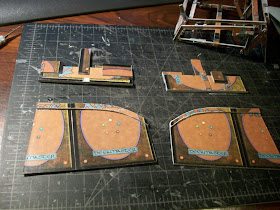Initial development tests used printer paper rolls to achieve the proper thickness. The resultant product deformed significantly to be used, and wasn't replicable by the average person. Subsequent attempts using whittled bamboo sticks with paper rolls produced good results, but subpar capability to reproduce the results.
The goal then became to provide a consistent means of producing a 1:6 scale shotgun shell that YOU, the reader, could feasibly do in the comfort of your own desk, given the same tools I have. You probably have better things to do than make your own bullets, but it's always good to know you can save a bit of money for other things. Like more guns.
Using an existing Dragon shotgun shell as a model, I measured the dimensions and found that I'd need a 7.5mm long 3mm diameter cylindrical rod, and a 3.175mm diameter end cap about 0.5mm thick with a minor depression in the center. Those dimensions are mighty convenient... A 1/8" hole punch on two Magic: the Gathering cards glued together gets me the end cap dimensions. As for the 3mm diameter rods, I happen to know the perfect source!
GUNDAM runners. I ended up keeping my runners from my Airmaster, Aegis and Blitz Gundam kits. I got a few more from the Obitsu Multi Purpose Clear Stands I bought. They both have diameters of 3mm for the runners. Excellent. And there's also runners that come in red! There's enough runner from one kit (or in this case, one Obitsu stand) to just cut down the smooth sections and ignore the sprues and gates. You only need 7.5mm of material and there's enough material to make about 40 rounds or more. I chose to smooth out the runners to form relatively smooth clear plastic rods, sand them lightly, then trim them down using a Dremel. A saw or knife works fine, but Dremel's for the impatient builder. Can't be bothered waiting 2 weeks, nor 5 minutes of sawing. Got to have my results in 3 seconds.
With your 7.5mm long rod sections, use some non-Elmer's glue like Loc-Tite to secure the disk to the end of the rod. The diameters shouldn't be flush, to simulate the rimmed edge of a shotgun shell. Lightly apply a coat of glue over the rim to thicken and seal the card edge. Your shells are almost done. On the other side, you can use a 1/16" drill tip to bore a small hole into the other end to simulate the packaged end.
Here's a photo of the completed shotgun shells on the left, and Dragon's shotgun shells on the right. Not quite the same, especially with the primer. It's only an issue if you really scrutinize the details up close. Far away, it's sufficient to work with for dioramas or piles of spent casings.
The front tips don't match very well, but comparing the results with other shells I've seen, a simple small 1/16" hole in the front is acceptable. My shells rather glow due to a lack of primer on the clear rods I used. They rather resemble red gummy bears right now. As a proof of concept, I think the results are acceptable. In terms of effort spent compared to just buying pre-made ones with more detail, if you're going to just toss them around, it's worth it. You won't need the extra little detail in your photos unless you plan on taking up-close images of piles of ammo.



















































